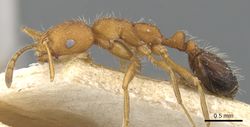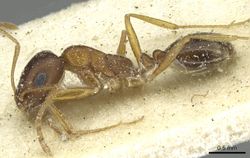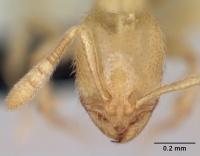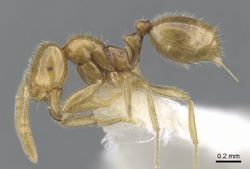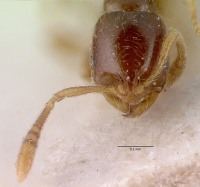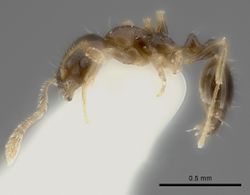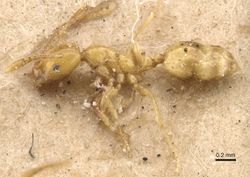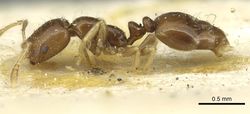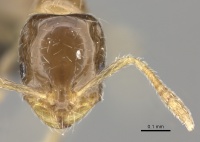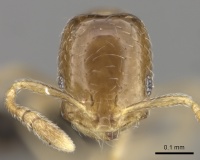Key to Afrotropical Erromyrma, Monomorium, Syllophopsis and Trichomyrmex species
No new species has been decribed since Bolton (1987)[1], who revises the genus for the Afrotropics.
As Monomorium has been split into Monomorium, Syllophopsis and Trichomyrmex, this key is modified to adapt to the new nomenclature
1
2
return to couplet #1
- Mandibles sculptured; either longitudinally rugose. or striate-rugulose, or costulate, or having a granular mat with superimposed fine striae over most or all of the mandible; the sculpture usually very conspicuous, the mandibles never smooth …..3
- Mandibles unsculptured; either entirely smooth and highly polished, or smooth with scattered hair-pits. or at most with 1-2 minute striae at the extreme base; mandibles never with extensive conspicuous sculpture as described above …..66
3
return to couplet #2
- With the head in full-face view the cephalic dorsum from the level of the midlength of the eyes to the occipital margin with surface sculpture present other than small separated hair-pits. The sculpture may be striate. reticulate-punctate, shagreened, granular, or a combination of these; or the surface may have only feeble to vestigial superficial reticular patterning, but the surface is never entirely smooth and featurelessexcept for hair-pits …..4
- With the head in full-face view the cephalic dorsum from the level of the midlength of the eyes to the occipital margin without surface sculpture present, the entire surface smooth and featureless except for scattered hair-pits; very rarely a few fine transverse rugulae may occur at the occipital margin itself …..59
4
return to couplet #3
- Promesonotal dorsum with standing hairs present, at least a single pair at the pronotal humeri …..5
- Promesonotal dorsum without standing hairs of any description …..17
5
return to couplet #4
- Propodeal dorsum with numerous standing hairs, obviously more than a single pair …..6
- Propodeal dorsum without standing hairs or sometimes with a single pair at most …..10
6
return to couplet #5
- Basal (fourth) tooth of mandible only slightly smaller than third tooth. Scapes longer and head relatively long and narrow, SI 99-121, CI 73-83 …..7
- Basal (fourth) tooth of mandible reduced to a minute denticle which is only a fraction the size of the third tooth. Scapes shorter and head relatively short and broad, SI 63-88. CI 85-95 …..8
7
return to couplet #6
- Head. alitrunk. petiole, postpetiole and appendages bright orange to orange-yellow, the gaster dark brown to blackish, the two colours strongly contrasting. CI 81-83, SI 99-103; maximum diameter of eye 0.19-0-21 x HW ..... Monomorium hirsutum
- Entire body more or less uniformly coloured brown to blackish, sometimes gaster darker in shade but without strongly contrasting areas of colour as above. CI 73-78. SI 110-120; maximum diameter of eye 0.22-0.25 x HW ..... Monomorium albopilosum
8
return to couplet #6
- Dorsum of head and alitrunk entirely reticulate-punctate, without trace of striate or rugulose sculpture. First gastral tergite reticulate-punctate on basal one-third to one-half. Eyes weakly reniform in profile, their anterior margins drawn out into anteroventrally directed points..... Monomorium hannonis
- Dorsum of head, alitrunk or both with striate or rugulose sculpture present at least in part, or partially smooth; not evenly reticulate-punctate everywhere. First gastral tergite smooth basally except for hair-pits. Eyes oval in profile …..9
9
return to couplet #8
- Dorsal surfaces of head and alitrunk all evenly coarsely sculptured, the propodeum not more strongly sculptured than the head and promesonotum. Body colour light brown to blackish brown..... Trichomyrmex emeryi
- Dorsal surfaces of head and alitrunk not evenly coarsely sculptured, the propodeum more strongly sculptured than the head and promesonotum, the latter usually with extensive smooth areas; cephalic sculpture very faint. Body colour yellow..... Trichomyrmex oscaris
10
return to couplet #5
- Sculpture of promesonotal dorsum virtually effaced, leaving the surface smooth and with faint to vestigial superficial reticular patterning only …..11
- Sculpture of promesonotal dorsum consisting of dense reticulate-punctation or of strong and conspicuous reticulation, the sculpture always distinct …..12
11
return to couplet #10
- Yellow species with HW <0.65, 51 102-105; eyes with maximum diameter 0.33 x I IW..... Monomorium ilgii
- Glossy dark brown species with NW >0-75, SI 114-122; eyes with maximum diameter 0-22-0.25 x HW..... Monomorium excelsior
12
return to couplet #10
- Dorsum of head from level of midlength of eyes to occipital margin uniformly densely blanketed with sharply defined reticulate-punctate sculpture …..13
- Dorsum of head from level of midlength of eyes to occipital margin not uniformly blanketed with sharply defined reticulate-punctate sculpture; either the surface finely shagreened with a few punctulate patches, or only with fine shagreening, reticulation or with superficial reticular patterning only …..15
13
return to couplet #12
- Ventral surface of head with numerous extremely long anteriorly curved "J"-shaped ammochaete hairs (Fig. 36). Scapes relatively long, SI 117-128..... Monomorium rufulum
- Ventral surface of head with a few short hairs which may be straight or curved, but lacking long "J"-shaped ammochaete hairs. Scapes relatively short. ST 85-115 …..14
14
return to couplet #13
- Small species, HW 040-0.48; SI 104-115 (Figs 56, 60). Eyes with 7 or fewer (usually 6) ommatidia in the longest row. Head and alitrunk yellow to very light yellow-brown..... Monomorium pharaonis
- Larger species, HW 0.57-0.80; SI 85-100. Eyes with 9-11 ommatidia in the longest row. Head and alitrunk dark brown to blackish..... Monomorium junodi
15
return to couplet #12
- Eyes with maximum diameter 0.22-0-24 x HW; scapes short and head broad. SI 88-95, CI 80-85. Projecting median portion of clypeus with its anterior free margin conspicuously concave..... Monomorium delagoense
- Eyes with maximum diameter 0.27-0-31 x HW; scants long and head narrow, SI 113-130, CI 70-76. Projecting median portion of clypeus with its anterior free margin transverse to convex …..16
16
return to couplet #15
- Pronotum with a single pair of standing hairs, situated at the humeri (Fig. 55). SI 113-120 Alitrunk dark brown to blackish, approximately the same colour as the gaster..... Monomorium vatranum
- Pronotum with 2-3 pairs of standing hairs on the dorsum behind the pair situated at the humeri (Fig. 50). SI 124-130. Alitrunk light to dull orange, the gaster dark brown to black and distinctly much darker than the alitrunk..... Monomorium marshi
17
return to couplet #4
- First gastral tergite with appressed pubescence but lacking standing (erect to subdecumbent) longer hairs anterior to the transverse row at the apex of the sclerite; sometimes even the apical transverse row of hairs absent …..18
- First gastral tergite with appressed pubescence and always with standing (erect to subdecumbent) longer hairs also present anterior to the transverse row at the apex of the sclerite. Standing hairs on the first gastral tergite varying from numerous to a single pair situated at one-third or one-half of the length of the sclerite …..28
18
return to couplet #17
- Dorsum of head uniformly blanketed with granular or shagreenate sculpture, or uniformly reticulate-punctate, the surface opaque …..19
- Dorsum of head only with very faint superficial reticular patterning which appears inlaid into the surface, without raised or roughened sculpture, the surface polished smooth and shining …..24
19
return to couplet #18
- With the head in profile the eyes drawn out anteroventrally into a point or lobe, the long axis of the eye directed obliquely downwards from back to front and very obviously out of alignment with the long axis of the head. Eyes situated in front of the midlength of the sides of the head. Fourth (basal) tooth of mandible much smaller than the third and frequently reduced to an offset small denticle. Scapes shorter, SI 80-90 …..20
- With the head in profile the eyes normal, not drawn out anteroventrally into a point or lobe, the long axis of the eye about parallel to the long axis of the head. Eyes situated at or very near to the midlength of the sides of the head. Fourth (basal) tooth of mandible as large as or only slightly smaller than the third. Scapes longer. SI 98-116 …..22
20
return to couplet #19
- Eyes relatively large, maximum diameter 0.29-0.33 x HW, conspicuously reniform in profile and with the ventral ocular margin concave..... Monomorium setuliferum
- Eyes smaller, maximum diameter 0.23-0-28 x 11W, drawn out into a lobe or point antero-ventrally but not reniform, the ventral ocular margin shallowly convex to flat or rarely extremely feebly concave …..21
21
return to couplet #20
- Sculpture on dorsum of pronotum entirely of sharply defined reticulate punctation. Posterior one-third of cephalic dorsum reticulate-punctate. ..... Monomorium ebangaense
- Sculpture on dorsum of pronotum of partially effaced or shagreenate reticulate-punctation, the punctures not sharply defined everywhere and frequently only with a shagreenate appearance. Posterior one-third of cephalic dorsum silky or even striolate, the sculpture with a smeared amorphous appearance, not sharply reticulate-punctate...... Monomorium notulum
22
return to couplet #19
- With the head in profile the posteroventral occipital angles not broadly evenly convex; instead the angles are either bluntly right-angled or acute. Viewed from above and behind the posteroventral occipital angles prominent and acute. Dorsum of head from level of midlength of eyes to occipital margin usually uniformly sharply reticulate-punctate. Maximum diameter of eyes 0.24-0.27 x HW. Larger species, HW 0.66-0.80..... Monomorium afrum
- With the head in profile the posteroventral occipital angles evenly broadly rounded. Viewed from above and behind the posteroventral occipital angles broadly rounded, not prominent. Dorsum of head from level of midlength of eyes to occipital margin usually not uniformly reticulate-punctate but instead granulate to shagreenate, with a silky appearance or with extremely fine striolae. Either eyes large, maximum diameter 0.30-0.35 x HW (with HW range 0.67-0.88), or much smaller species with HW 0.42-051 …..23
23
return to couplet #22
- Eyes with 12-14 ommatidia in the longest row. Larger species with broader head and shorter scapes, HW 0.67-0.88, CI 78-88, SI 98-104. With alitrunk in profile the promesonotal outline with the posterior portion of the mesonotum sharply downcurved and descending to the impressed metanotal groove..... Monomorium areniphilum
- Eyes with 7-9 ommatidia in the longest row. Smaller species with narrower head and longer scapes, HW 0.42-0.51, CI 72-75, SI 110-116. With alitrunk in profile the promesonotal outline approximately flat to the metanotal groove..... Monomorium damarense
24
return to couplet #18
- With the head in full-face view the eyes situated conspicuously in front of the midlength of the sides …..25
- With the head in full-face view the eyes situated at or very close to the midlength of the sides …..26
25
return to couplet #24
- Dark brown larger species. HW 0-56-0-68. Eyes larger, maximum diameter 0.33-0.36 x HW In profile the eyes drawn out into an anteroventrally directed lobe, the eyes weakly reniform in shape. Head somewhat broader and scapes shorter, CI 79-83, SI 80-90..... Monomorium alamarum
- Yellow smaller species, HW 0.33-0.36. Eyes smaller, maximum diameter 0-26-0.28 x HW. In profile the eyes approximately oval. Head somewhat narrower and scapes longer. CI 75-77, SI 92-97..... Monomorium rabirium
26
return to couplet #24
- Node of petiole with a single pair of hairs, which project posteriorly. Scapes slightly longer and eyes larger, SI 95-100. maximum diameter of eyes 0.26-0.28 x HW ..... Monomorium nirvanum
- Node of petiole without projecting hairs. Scapes slightly shorter and eyes smaller. SI 90-95, maximum diameter of eyes 0.21-0.25 x HW …..27
27
return to couplet #26
- Yellow species with relatively broad head, CI 80-84. Eyes exactly at midlength of sides of head and their maximum diameter 0.21-0.24 x HW ..... Monomorium mediocre
- Blackish brown species with relatively narrow head, CI 77-78. Eyes slightly in front of midlength of sides of head and their maximum diameter 0.24-0.25 x HW ..... Monomorium esharre
28
return to couplet #17
- Eyes extremely large, maximum diameter 0.37-0.40 x HW, and scapes with SI > 110 ..... Monomorium viator
- Either eyes smaller, maximum diameter <0-36 x HW, or scapes shorter, SI < 110, or both …..29
29
return to couplet #28
- Dorsum of head from level of midlength of eyes to occipital margin with extremely faint vestigial superficial reticular patterning only, the surface polished and shining …..30
- Dorsum of head from level of midlength of eyes to occipital margin with granular or shagreenate sculpture, or uniformly reticulate-punctate, the surface opaque and never only with superficial reticular patterning …..36
30
return to couplet #29
- Dorsum of head behind level of frontal lobes with appressed pubescence but without standing hairs of any description …..31
- Dorsum of head behind level of frontal lobes with oppressed pubescence and with standing hairs also present. The standing hairs are usually sparse and arranged in pairs on each side of the midline; generally a conspicuous pair present close to the point where the dorsum curves into the occipital margin …..33
31
return to couplet #30
- Eyes relatively large and scopes relatively short; maximum diameter of eye 0.35 x HW and SI 92 ..... Monomorium ophthalmicum
- Either eyes relatively small or scopes relatively long, or both; maximum diameter of eye <0.35 x HW (range 0.24-0.31 x HW) and SI 88-102. but if SI 88-93 then eyes are only 0.24-0.26 x HW …..32
32
return to couplet #31
- Alitrunk in profile with promesonotal dorsal outline evenly convex from front to back, highest at about the midlength. Propodeal dorsal outline forming a separate surface behind the conspicuous metanotal groove, not merely continuing the slope of the promesonotal dorsum. HW 0.50-0.60. CI 79-93, SI 88-93: maximum diameter of eye 0.24-0.26 x HW ..... Monomorium willowmorense
- Alitrunk in profile with promesonotal dorsal outline almost flat and sloping from front to back, its highest point well in front of the midlength. Propodeal dorsal outline continuing the slope of the promesonotum behind the virtually unimpressed metanotal groove. HW 0.43-0.45, CI 73-75, SI 100-102: maximum diameter of eye 0.29-0-31 x HW ..... Monomorium kitectum
33
return to couplet #30
- Small species with relatively large eyes. HW 0.46-0.52, maximum diameter of eye 0.28-0.32 x HW. CI 73-78. Peduncle of petiole anteroventrally with a conspicuous lamellate blunt tooth or prominent lobe ..... Monomorium drapenum
- Larger species with relatively small eyes. HW 0.67-0.80, maximum diameter of eye 0.21-0.23 x HW. CI 80-86. Peduncle of petiole anteroventrally with an angle which is usually broadly and bluntly rounded, without a lamellate tooth or prominent lobe …..34
34
return to couplet #33
- Sculpture of promesonotal dorsum almost effaced. Node of postpetiole dorsally unsculptured smooth and shining. With propodeum in dorsal view the posteriorly divergent ridges separating the dorsum from the sides sharply defined and narrowly rounded ..... Monomorium orangiae
- Sculpture of promesonotal dorsum fine but conspicuous. Node of postpetiole dorsally with fine granular to punctulate sculpture. With propodeum in dorsal view the posteriorly divergent ridges separating the dorsum from the sides very poorly defined and broadly rounded, often virtually effaced …..35
35
return to couplet #34
- Slightly larger species with fractionally broader head and shorter scapes. HW 0.74-0.82. CI 82-86. SI 95-100 ..... Monomorium tchelichofi
- Slightly smaller species with fractionally narrower head and longer scopes, HW 0.67-0.68, CI 80-81, SI 101-103 ..... Monomorium fridae
36
return to couplet #29
- With the head in full-face view the cephalic dorsum from the level of the posterior margins of the eyes to the occipital margin uniformly densely reticulate-punctate; each puncture sharply defined and either of approximately equal size over the entire surface or becoming smaller posteriorly; without trace of any other form of sculpture …..37
- With the head in full-face view the cephalic dorsum from the level of the posterior margins of the eyes to the occipital margin not uniformly reticulate-punctate. Instead the surface is more or less opaque, with shagreenate to punctate-shagreenate or extremely fine striolate sculpture, or with a silky, smeared or roughened appearance; but not having sharply defined reticulate punctation everywhere …..44
37
return to couplet #36
- Head and alitrunk uniformly brown to black, the gaster approximately the same colour or slightly darker, not strongly contrasting with the head and alitrunk …..38
- Head and alitrunk red to bright orange-yellow, frequently orange-red, the gaster much darker and strongly contrasting with the head and alitrunk …..40
38
return to couplet #37
- First gastral tergite with about 10 pairs of hairs in front of the apical transverse row. Smaller species, HW 0.48. SL O.50-0.51. PW 0.33-0.34 ..... Monomorium micropacum
- First gastral tergite with only 1-2 pairs of hairs in front of the apical transverse row. Larger species, HW > 0.60, SL > 0.60, PW > 0.40 …..39
39
return to couplet #38
- In profile the propodeal dorsum sloping posteriorly, the junction of dorsum and declivity indicated by a sharply defined or subdentate angle ..... Monomorium subdentatum
- In profile the propodeal dorsum about horizontal the dorsum rounding evenly into the declivity without passing through a sharp or subdentate angle ..... Monomorium opacum
40
return to couplet #37
- Basal (fourth) tooth of mandible reduced to a minute denticle, only a fraction the size of the third tooth. Ventral surface of head with numerous extremely long anteriorly curved J-shaped ammochetae hairs ..... Monomorium rufulum
- Basal (fourth) tooth of mandible either about the same size as the third tooth or only slightly smaller, not reduced to a minute denticle. Ventral surface of head with simple hairs which may be straight or curved, but lacking extremely long "J"-shaped hairs …..41
41
return to couplet #40
- Eyes relatively large, maximum diameter 0.31-0.33 x HW ..... Monomorium personatum
- Eyes relatively small, maximum diameter 0.23-0.27 x HW …..42
42
return to couplet #41
- Pilosity on basal half of first gastral tergite sparse, usually with only 1-3 pairs of hairs. Very rarely 4 pairs may occur, in which case the anterior free margin of the median portion of the clypeus is shallowly impressed. the projecting angles on each side of the impression low broad and blunt ..... Monomorium bicolor
- Pilosity on basal half of first gastral tergite dense, usually with 6-8 pairs of hairs. If pilosity at lower end of this range then the anterior free margin of the median portion of the clypeus is deeply indented and the projecting angles on each side of the indentation form sharp prominent teeth …..43
43
return to couplet #42
- Anterior face margin of median portion of clypeus concave in full-face view, the concavity flanked by a pair of freely projecting acute teeth ..... Monomorium westi
- Anterior face margin of median portion of clypeus shallowly concave in full-face view and flanked by a pair of bluntly rounded angles, without projecting teeth ..... Monomorium dictator
44
return to couplet #36
- Standing hairs on first gastral tergite, discounting the apical transverse row, numerous and more or less evenly distributed; obviously with more than 3 pairs present and the hairs not restricted to the basal half of the sclerite …..45
- Standing hairs on first gastral tergite. discounting the apical transverse row, sparse and restricted in distribution: with only 1-3 pairs present which are generally confined to the basal half of the seternite. When only one pair present it is usually at the midlength …..50
45
return to couplet #44
- Alitrunk and gaster approximately the same colour, the two not strongly contrasting …..46
- Alitrunk and gaster conspicuously differently coloured, the two obviously strongly contrasting …..48
46
return to couplet #45
- Dimensions in range HW 0.53-0.60, SL 0.62-0.72, CI 74-77, SI 117-122 ..... Monomorium mantazenum
- Dimensions in range HW 0.43-0.51, SL 0.44-0.58, CI 70-74. SI 102-116 …..47
47
return to couplet #46
- Uniformly yellow species. SI 108-116. Maximum diameter of eye 0.26-0.40 x HW..... Monomorium minor
- Uniformly brown species. SI 102-107. Maximum diameter of eye 0.24-0.26 X HW..... Monomorium carbo
48
return to couplet #45
- Larger species. HW O.59-0.69, SL 0.60-0.70, PW 0.43-0.48, length of hind femur 0.70-0.82, maximum diameter of eye 0.16-0.17. Propodeal dorsum shallowly but distinctly transversely concave. In available material larger workers with a single ocellus present..... Monomorium ocellatum
- Smaller species, HW 0.44-0.47. SL 0.44-0.45, PW 0.30-0.31, length of hind femur 0.48-0.50, maximum diameter of eye 0.10-0.14. Propodeal dorsum not concave. No ocelli developed .....49
49
return to couplet #48
- Head and alitrunk orange-yellow, gaster blackish brown. Maximum diameter of eye 0.23-0.24 x HW, with 7-8 ommatidia in the longest row..... Monomorium dakarense
- Head and alitrunk medium yellowish brown, gaster dark brown. Maximum diameter of eye 0.30 x HW, with 10 ommatidia in the longest row..... Monomorium parvinode
50
return to couplet #44
- Eye with 10 or more ommatidia in the longest row. HW 0.50-0.88 …..51
- Eye with 7-9 ommatidia in the longest row. HW 0.43-0.52 …..54
51
return to couplet #50
- Dorsal outline of alitrunk in profile very characteristically shaped, the posterior one-third or more of the mesonotum suddenly downcurved and descending steeply to the metanotal groove. Larger species, HW 0.67-0-88. ..... Monomorium areniphilum
- Dorsal outline of alitrunk in profile not shaped as above, the posterior one-third of the mesonotum continuing the even gradually curved slope of the anterior portion, not suddenly downcurved and steeply descending. Smaller species, HW 0.50-0.64 …..52
52
return to couplet #51
- Smaller species with relatively very large eyes, HW 0.50-0-57, maximum diameter of eye 0.35-0.38 x HW..... Monomorium sutu
- Larger species with relatively small eyes, HW 0.54-0.64, maximum diameter of eye 0.24-0-30 x HW …..53
53
return to couplet #52
- Prominent median section of clypeus with its anterior free margin indented centrally. Dorsum of head with 0-1 pairs of standing hairs behind the level of the frontal lobes. Maximum diameter of eye 0.27-0.30 x HW. Promesonotum reticulate-punctate dorsally. Cephalic sculpture strong, granulate to shagreenate-punctate..... Monomorium subopacum
- Prominent median section of clypeus with its anterior free margin transverse. Dorsum of head with 3-4 pairs of standing hairs behind the level of the frontal lobes. Maximum diameter of eye 0.24-0.26 x HW. Promesonotum with weak reticular patterning dorsally. Cephalic sculpture feeble, superficially reticulate without overlying granulate or shagreenate-punctate component..... Monomorium herero
54
return to couplet #50
- Antenna] scapes both absolutely and relatively shorter, SL 0.40-0-43, SI 89-93..... Monomorium disertum
- Antennal scapes both absolutely and relatively longer, SL 0-47-0.57, SI 100-110 …..55
55
return to couplet #54
- Shagreenate-granular sculpture of dorsal head and pronotum strongly developed, the surfaces everywhere dull and opaque …..56
- Shagreenate-granular sculpture of dorsal head and pronotum very feebly developed, the surfaces semi-smooth and weakly shining …..57
56
return to couplet #55
- Dorsum of head with 2 pairs of standing hairs behind level of frontal lobes. Eyes averaging somewhat smaller,0.24-0.26 x HW..... Monomorium opacior
- Dorsum of head without standing hairs behind level of frontal lobes. Eyes averaging somewhat larger, 0.27-0-31 x HW..... Monomorium damarense
57
return to couplet #55
- Entirely yellow..... Monomorium termitarium
- Head and alitrunk medium brown, gaster dark brown …..58
58
return to couplet #57
- Dorsum of pronotum finely shagreenate, with a roughened silky appearance; dorsum of mesonotum reticulate-punctate, the two forms of sculpture contrasting. Slightly smaller species. HW 0.47, SL 0-47..... Monomorium anceps
- Dorsum of pronotum finely reticulate, dorsum of mesonotum reticulate-punctate; the two not contrasting but rather the sculpture of the former appearing as a reduced version of that of the latter. Slightly larger species, HW 0.50-0-52, SLO-50-0-54..... Monomorium australe
59
return to couplet #3
- Propodeal spiracle vertically slit-shaped or elliptical. Anterior clypeal margin with a pair of prominent strong teeth which overhang the mandibles (Figs 31, 32), these teeth widely separated and the distance between them greater than the maximum width across the frontal lobes..... Trichomyrmex abyssinicus
- Propodeal spiracle circular to subcircular. Anterior clypeal margin lacking prominent teeth of any description …..60
60
return to couplet #59
- Propodeal dorsum reticulate-punctate. Eyes relatively large, maximum diameter 0.27-0.33 x HW …..61
- Propodeal dorsum finely transversely striolate to transversely rugulose, sometimes the sculpture very reduced in small workers so that the surface appears virtually smooth. Eyes relatively small, maximum diameter 0.13-0.20 x HW …..62
61
return to couplet #60
- Mesonotum and propodeum dorsally with standing hairs present. Mandibles with only 3 teeth Larger species with relatively broad head and short scapes, HW 0.62-0.69, CI 86-90, SI 78-82; maximum diameter of eye 0.27-0.30 x HW ..... Monomorium havilandi
- Mesonotum and propodeum dorsally without standing hairs or the former with a single short pair (Fig. 59). Mandibles with 3 teeth plus a smaller basal denticle. Smaller species with relatively narrow head and longer scapes, HW 0.42-0.45, CI 78-80, SI 84-90; maximum diameter of eye 0.31-0.33 x HW..... Monomorium macrops
62
return to couplet #60
- Head yellow, alitrunk dark brown, gaster yellow; the colours of the head and alitrunk strongly contrasting..... Trichomyrmex epinotalis
- Head and alitrunk uniformly yellow or uniformly brown, gaster approximately the same colour or darker; the colours of the head and alitrunk not strongly contrasting …..63
63
return to couplet #62
64
return to couplet #63
- Species with very little size variation in any given sample, without transverse fine rugular sculpture on the posterior surface of the head where it curves down towards the occipital foramen..... Trichomyrmex robustior
- Species with marked size variation in any given sample, the medium to large workers with transverse fine rugulose sculpture on the posterior surface of the head where it curves down towards the occipital foramen ..... Trichomyrmex mayri
65
return to couplet #63
- Petiole node in dorsal view subglobular; postpetiole node in dorsal view only slightly broader than long..... Trichomyrmex destructor
- Petiole node in dorsal view transverse, distinctly compressed from front to back and obviously much broader than long; postpetiole node in dorsal view distinctly broader than long..... Trichomyrmex oscaris
66
return to couplet #2
- Eyes minute and point-like, consisting of only one or two ommatidia ..... 67
- Eyes conspicuous, distinctly with more than two ommatidia ..... 74
67
return to couplet #66
- Metanotal groove in profile a simple indentation of the surface which is scarcely impressed. Propodeum in absolute profile with the dorsum and declivity meeting in a rounded or sharp angle, but without small teeth or projecting denticles at their junction..... Syllophopsis modesta
- Metanotal groove in profile a sharply impressed "U"- or "V"-shaped depression. Propodeum in absolute profile with the dorsum and declivity meeting in a sharp angle which is usually equipped with a minute but conspicuous projecting denticle …..68
68
return to couplet #67
69
return to couplet #68
- Lower half of mesopleuron sculptured. Propodeum in dorsal view with a short transverse crest behind the metanotal groove, this crest appearing as a narrow acute peak in profile at the summit of the propodeum immediately behind the metanotal groove..... Syllophopsis malamixta
- Lower half of mesopleuron smooth. Propodeum in dorsal view without a transverse crest behind the metanotal groove, in profile the propodeal dorsum raised and narrowly rounded immediately behind the metanotal groove but this raised portion not surmounted by an acute peak ..... Syllophopsis cryptobia (part)
70
return to couplet #68
- Lower half of mesopleuron sculptured..... Syllophopsis sersalata
- Lower half of mesopleuron smooth …..71
71
return to couplet #70
- Smaller species, HL 0.36-0.43, HW 0.28-0.34, SL 0.26-0.31 ..... Syllophopsis cryptobia (part)
- Larger species, HL 0.46-0.55, HW 0.38-0.43, SL 0.36-0.44 …..72
72
return to couplet #71
- Antennal scapes relatively short , SI 91-95 ..... Syllophopsis elgonensis
- Antennal scapes relatively long, SI 103-110 …..73
73
return to couplet #72
- Pubescence of scapes and of sides of head behind eyes dense and erect to suberect ..... Syllophopsis thrascolepta
- Pubescence of scapes and of sides of head behind eyes sparse and short, appressed. CI 72-75 ..... Syllophopsis jonesi
74
return to couplet #66
- Dorsum of propodeum sculptured, even if only feebly so, the sculpture consisting of fine transverse striation or reticulate-punctation …..75
- Dorsum of propodeum unsculptured. smooth and shining everywhere …..88
75
return to couplet #74
- Dorsal surfaces of alitrunk and first gastral tergite without standing hairs …..76
- Dorsal surfaces of alitrunk or first gastral tergite, or both, with standing hairs present …..78
76
return to couplet #75
- Cephalic dorsum finely shagreenate everywhere except for a smooth median longitudinal narrow strip ..... Monomorium osiridis
- Cephalic dorsum smooth or at most sculptured with only the faintest vestiges of superficial reticular patterning …..77
77
return to couplet #76
- Pronotal dorsum reticulate to shagreenate. Cephalic dorsum with sculpture close to the occipital margin. SI 92-97 ..... Monomorium rabirium
- Pronotal dorsum unsculptured. Cephalic dorsum smooth with scattered hair-pits close to the occipital margin. SI 85-88 ..... Monomorium zulu
78
return to couplet #75
- Mandibles with 5 teeth which decrease in size from apex to base. PF 3,3. ..... Erromyrma latinodis
- Mandibles with 4 teeth, or 3 teeth plus an offset basal denticle, or with only 3 teeth. PF 2,2 or less …..79
79
return to couplet #78
- Central portion of clypeus in full-face view with a pair of strongly anteriorly divergent sharp carinae which terminate in a pair of freely projecting teeth or denticles anteromedially. Frontal lobes closely approximated, the posteriormost portion of the clypeus which runs between them reduced to a narrow strip which is only slightly wider than either of the frontal lobes ....80
- Central portion of clypeus in full-face view without strongly anteriorly divergent sharp carinae and lacking freely projecting teeth or denticles anteromedially. Instead the margin here is convex to shallowly concave. Frontal lobes farther apart, the posteriormost portion of the clypeus which runs between them distinctly much wider than either of the frontal lobes ....83
80
return to couplet #79
- Propodeal dorsum strongly transversely rugulose. Mesopleuron, metapleuron and sides of propodeum mostly densely sculptured, smooth areas restricted to immediate vicinity of propodeal spiracle and a small patch high on the mesopleuron ..... Monomorium jacksoni
- Propodeal dorsum feebly to vestigially transversely striolate. Mesopleuron, metapleuron and sides of propodeum mostly to entirely smooth, at most with patches of sculpture over the metapleural gland bulla and at the extreme base of the mesopleuron …..81
81
return to couplet #80
- Body colour uniform blackish brown to jet black ..... Monomorium invidium
- Body colour light to medium brown ..... Monomorium hanneli
82
return to couplet #81
NOT VALID AS M.valtinum has become a Junior Synonym of Monomorium hanneli
- Eyes consisting of only 6-7 ommatidia, their maximum diameter 0.43-0.45 x HW .....Monomorium valtinum =Monomorium hanneli
- Eyes consisting of more than 10 ommatidia, their maximum diameter 0.16-0.18 x HW
83
return to couplet #79
- Fourth (basal) tooth of mandible only slightly smaller than the third, not reduced to a minute offset basal denude, nor widely separated from the third tooth. Dorsum and sides of propodeum blanketed everywhere with dense reticulate-punctate sculpture …..84
- Fourth (basal) tooth of mandible minute, reduced to a tiny offset denticle which is much smaller than the third tooth and is widely separated from it. Dorsum and sides of propodeum not uniformly reticulate-punctate, instead the dorsum is minutely and usually faintly transversely striolate and the sides lack sculpture at least in part …..85
84
return to couplet #83
- Larger species, HW 0.38-0.46, SL 0.33-0.38, AL 0.50-0.54; CI 88-92 ..... Monomorium malatu
- Smaller species, HW 0-34, SL 0.30, AL 0.40; CI 81 ..... Monomorium affabile
85
return to couplet #83
- Head yellow, alitrunk dark brown, gaster yellow; the colours of the head and alitrunk strongly contrasting ..... Trichomyrmex epinotalis
- Head and alitrunk uniformly yellow or uniformly brown, the gaster approximately the same colour or darker; the colours of the head and alitrunk not strongly contrasting …..86
86
return to couplet #85
- Head and alitrunk brown, usually dark brown ..... Trichomyrmex mayri
- Head and alitrunk yellow …..87
87
return to couplet #86
- Petiole node in dorsal view subglobular; postpetiole node only slightly broader than long ..... Trichomyrmex destructor
- Petiole node in dorsal view transverse, distinctly compressed from front to back and obviously much broader than long; postpetiole node. distinctly broader than long ..... Trichomyrmex oscaris
88
return to couplet #74
- Eye in profile drawn out anteriorly into a very long lobe or prominence which projects anteroventrally across and down the side of the head, almost extending onto the ventral surface of the head ..... Monomorium xanthognathum
- Eye oval to more or less round in profile, not drawn out into a long anteroventrally projecting lobe …..89
89
return to couplet #88
- Frontal lobes closely approximated, the posteriormost portion of the clypeus which runs between them reduced to a very narrow strip which is only fractionally wider than either of the frontal lobes. Dorsum and declivity of propodeum meeting in a pronounced angle .....90
- Frontal lobes farther apart, the posteriormost portion of the clypeus which runs between them distinctly much wider than either of the frontal lobes. Dorsum and declivity of propodeum in profile rounding together or forming a single continuous curve, not meeting in a pronounced angle …..91
90
return to couplet #89
- Petiole and postpetiole very narrow and scale-like in profile, the postpetiole especially markedly anteroposteriorly compressed. In dorsal view the postpetiole dorsum scarcely thicker than the petiole ..... Monomorium guineense
- Petiole and postpetiole not scale-like in profile, the postpetiole nodiform. In dorsal view the postpetiole dorsum distinctly thicker than the petiole ..... Monomorium invidium (part)
91
return to couplet #89
- With the head in profile the eye consisting of a peripheral ring of ommatidia encircling a single longitudinal row of ommatidia within the ring …..92
- With the head in profile the eye consisting of a peripheral ring of ommatidia encircling two or more longitudinal rows of ommatidia within the ring …..97
92
return to couplet #91
- Promesonotal dorsum with only a single pair of standing hairs, at the pronotal humeri Propodeal dorsum without standing hairs ..... Monomorium sryetum
- Promesonotal dorsum with more than one pair of standing hairs. Propodeal dorsum with at least one pair of standing hairs present …..93
93
return to couplet #92
- Dorsum of head brown, varying from medium brown to blackish brown …..94
- Dorsum of head yellow, varying from pale yellow to dingy yellow …..95
94
return to couplet #93
- Head and alitrunk the same shade of brown, species not bicoloured. Anterior clypeal margin broadly and evenly convex between the inner points of the mandibular insertions. SI 76-79. Maximum diameter of eye 0.16 x HW ..... Monomorium inquietum
- Head brown to blackish brown, the alitrunk lighter, usually yellow so that the species is bicoloured. Anterior clypeal margin with a clearly differentiated prominent median section, not evenly convex between the inner points of the mandibular insertions. SI 86-94. Maximum diameter of eye 0.21-0.24 x HW. ..... Monomorium floricola
95
return to couplet #93
- Maximum diameter of eye 0.23-0.24 x HW. First gastral tergite uniformly yellow ..... Monomorium shilohense
- Maximum diameter of eye 0.17-0.19 x HW. First gastral tergite with basal half pale yellow, apical half brown …..96
96
return to couplet #95
- Small species with relatively short stapes, HW 0.30, SL 0.22, SI 73 ..... Monomorium trake
- Larger species with relatively longer scapes, HW 0.34-0.38. SL. 0.28-0.30, SI 79-83 ..... Monomorium rotundatum
97
return to couplet #91
- Larger species with relatively very short antennal scapes, HW 0.72-0.74, SI 73-75. Promesnotum with 20 or more pairs of standing hairs ..... Monomorium iyenasu
- Smaller species with relatively longer antennal scapes, HW 0.30-0.55. SI 75-110; if SI <80 then species is minute with HW at lower end of the range. Promesonotum with fewer than 12 (usually 3-10) pairs of standing hairs …..98
98
return to couplet #97
- Viewed from behind and slightly above the pronotum transversely almost to quite flat and the humeri conspicuously angular ….. Monomorium egens
- Viewed from behind and slightly above the pronotum transversely evenly shallowly convex and the humeri evenly broadly rounded …..99
99
return to couplet #98
- Strikingly bicoloured species with alitrunk , petiole and postpetiole black to blackish brown. The head and its appendages, gaster and legs clear yellow. Some individuals may present the head black ….. Monomorium mirandum
- Colour various shades of yellow, brown or black; usually a uniform single colour and never strikingly bicoloured as above …..100
100
return to couplet #99
- In full-face view the antennal scapes, when laid straight back from their insertions, just reaching to slightly exceeding the occipital margin. SI 95-110 …..101
- In full-face view the antennal scapes, when laid straight back from their insertions, failing to reach the occipital margin. SI 75-98 .....113
101
return to couplet #100
- Promesonotum in profile with only 3 pairs of standing hairs. With head in full-face view the posterior margins of the eyes distinctly in front of the midlength of the sides ….. Monomorium termitobium
- Promesonotum in profile with 4 to more than 8 pairs of standing hairs. With head in full-face view the posterior margins of the eyes at or very close to the midlength of the sides …..102
102
return to couplet #101
- Very small pale yellow species, HW 0.30-0.32, SL 0.30-0.34 …..103
- Either larger yellow species, HW 0.38-0.50, SI 0.38-0.56, or colour conspicuously dark brown to black …..104
103
return to couplet #102
- Occipital margin of head broadly and shallowly concave in full-face view. Propodeal spirade minute and pinhole-like. SI 106-107, CI 75-76 ….. Monomorium speluncarum
- Occipital margin of head convex in full-face view. Propodeal spiracle conspicuous, not minute and pinhole-like. SI 95-100, CI 78-84 ….. Monomorium gabrielense
104
return to couplet #102
- Colour brown to black. Alitrunk in profile with promesonotum strongly domed-convex, the highest point at about the midlength. Smaller species, HW 0.32-0.40, SL 0.32-0.42 …..105
- Colour yellow to light brown. Alitrunk in profile with promesonotum quite shallowly evenly convex, the highest point in front of the midlength. Generally larger species, HW 0.38-0.50, SL 0.38-0.56; species in the narrow zone where measurements overlap are very distinctly yellow in colour …..106
105
return to couplet #104
- Legs very pale indeed, conspicuously very much lighter than the alitrunk, sometimes virtually colourless. HL 0.39-0.42, SL 0.32-0.36, AL 0.44-0.46 ….. Monomorium draxocum
- Legs yellowish brown, only slightly lighter than alitrunk, always distinctly coloured. HL 0.46-0.50, SL 0.39-0.42, AL 0.54-0.58 ….. Monomorium noxitum
106
return to couplet #104
- With alitrunk in dorsolateral view the metanotal groove very narrow and traversed by extremely short and inconspicuous cross-ribs. Propodeal spiracle minute and pinhole-like …..107
- With alitrunk in dorsolateral view the metanotal groove broad and traversed by long sharply defined and conspicuous cross-ribs. Propodeal spiracle large and very obvious, not pinhole-like …..109
107
return to couplet #106
- Dingy light brown species. Promesonotum with 8 or more pairs of standing hairs dorsally. HL 0.60-0.63, HW 0.48-0.50 ….. Monomorium bevisi
- Yellow species. Promesonotum with 4-6 pairs of standing hairs dorsally. HL 0.50-0.58, HW 0.38-0.46 …..108
108
return to couplet #107
- Eyes slightly larger, maximum diameter 0.24-0.27 x HW. Scapes relatively shorter, SI 97-102 ….. Monomorium schultzei
- Eyes slightly smaller, maximum diameter 0.20-0.23 x HW. Scapes relatively longer, SI 104-110 ….. Monomorium excensurae
109
return to couplet #106
- Dorsal surface of propodeum transversely flat or even feebly concave between a pair of blunt and ill-defined low longitudinal rims which separate the dorsum proper from the sides ….. Monomorium kineti
- Dorsal surface of propodeum transversely convex, or if somewhat flattened then the flattened area not bounded by a pair of low longitudinal rims which separate the dorsum proper from the sides …..110
110
return to couplet #109
- Promesonotal dorsum with 4-6 pairs of standing hairs …..111
- Promesonotal dorsum with 8 or more pairs of standing hairs …..112
111
return to couplet #110
- With alitrunk in profile the metanotal groove forming a very broad shallow U-shaped trough. Propodeal dorsal outline behind the metanotal groove convex and rounded, the dorsum rounding evenly into the declivity so that the two surfaces form a single smooth convexity ….. Monomorium crawleyi
- With alitrunk in profile the metanotal groove shallowly impressed, not forming an extensive U-shaped trough. Propodeal dorsal outline behind the metanotal groove consisting of a more or less flat posteriorly-sloped zone which then rounds quite abruptly into the more steeply sloping declivity, the two surfaces not forming a single smooth convexity ….. Monomorium arboreum
112
return to couplet #110
- Subpetiolar process a conspicuous lobe. With the head in full-face view the sides behind the eyes with all hairs decumbent to appressed. SL 0.50-0.56 ….. Monomorium firmum
- Subpetiolar process a low ridge. With the head in full-face view the sides behind the eyes with all hairs suberect to subdecumbent. SL 0.39-0.48 ….. Monomorium vecte
113
return to couplet #100
- Propodeal spiracle with a large circular orifice which is very conspicuous and dominates the side of the propodeum …..114
- Propodeal spiracle with a small or minute circular orifice which usually appears as a pinhole in the side of the propodeum .....119
114
return to couplet #113
- Median clypeal carinae terminating at anterior clypeal margin in a pair of elongate subspini-form teeth which are usually somewhat curved towards the midline and which project out over the mandibles ….. Monomorium occidentale
- Median clypeal carinae terminating at anterior clypeal margin in a pair of short broad triangular denticles or merely a pair of acute or blunt angles; without elongate teeth which project out over the mandibles …..115
115
return to couplet #114
- Median portion of clypeus with its anterior free margin convex between the points of termination of the clypeal carinae; the carinae themselves low, rounded and poorly defined, and their points of termination not prominent ….. Monomorium kelapre
- Median portion of clypeus with its anterior free margin concave between the points of termination of the clypeal carinae; the carinae themselves conspicuous and their points of termination prominent as denticles or projecting angles …..116
116
return to couplet #115
117
return to couplet #116
- Nodes of both petiole and postpetiole high and narrow in profile, the postpetiole with a flat and vertical anterior face. SI 88-93 ….. Monomorium captator
- Nodes of petiole and postpetiole not high and narrow in profile, the postpetiole without a flat and vertical anterior face. SI 79-85 ….. Monomorium lene
118
return to couplet #116
- Dorsal alitrunk with only 4 pairs of standing hairs, of which 3 pairs are on the promesonotum and 1 pair on the propodeum. SI 90-93 ….. Monomorium borlei
- Dorsal alitrunk much more densely hairy, the promesonotum very obviously with more than 3 pairs and the propodeum with more than 1 pair of standing hairs. SI 83-86 ….. Monomorium madecassum
119
return to couplet #113
- Anterior and posterior faces of both petiole and postpetiole meeting in a sharp rim or edge which is continuous around the sides and dorsum of each node. Body colour glossy black ….. Monomorium vonatu
- Anterior and posterior faces of both petiole and postpetiole not meeting in a sharp continuous rim or edge, the two surfaces either rounding bluntly together or the petiole with a slight lateral rim which does not run onto the dorsum. If the latter then colour yellow …..120
120
return to couplet #119
- Eyes relatively very large, the maximum diameter 0.30 x HW or more. In general the maximum length of the eye in profile is markedly greater than the distance from the anteriormost point of the eye to the closest point of the mandibular articulation .....121
- Eyes relatively smaller, the maximum diameter <0.30 x HW. In general the maximum length of the eye in profile is usually distinctly less than the distance from the anteriormost point of the eye to the closest point of the mandibular articulation, but in a few species the two lengths may be about equal or the former fractionally greater than the latter …..124
121
return to couplet #120
- Uniformly dark brown to blackish brown species …..122
- Uniformly yellow to light brownish yellow species …..123
122
return to couplet #121
- Promesonotal dorsum with 8-10 pairs of standing hairs. Longest hairs projecting from first gastral tergite distinctly longer than maximum diameter of eye ….. Monomorium balathir
- Promesonotal dorsum with 3-4 pairs of standing hairs. Longest hairs projecting from first gastral tergite distinctly shorter than maximum diameter of eye ….. Monomorium manir
123
return to couplet #121
- Pronotum, mesonotum and propodeum each with a single pair of standing hairs, so that the alitrunk has only 3 pairs in total on the dorsum ….. Monomorium katir
- Pronotum, mesonotum and propodeum each with more than one pair of hairs, so that the alitrunk very obviously has more than 3 pairs in total on the dorsum ….. Monomorium holothir
124
return to couplet #120
- With the head in full-face view the eyes at or only fractionally in front of the midlength of the sides …..125
- With the head in full-face view the eyes distinctly in front of the midlength of the sides …..126
125
return to couplet #124
- Maximum diameter of eye 0.17-0.18 x HW. SI 86-88 ….. Monomorium tanysum
- Maximum diameter of eye 0.24 X HW. SI 92 ….. Monomorium disoriente
126
return to couplet #124
- Projecting median portion of clypeus with its anterior margin concave, the concavity flanked by a pair of triangular prominences or denticles (at the apices of the clypeal carinae), this pair of prominences separating the anterior and lateral margins of the projecting median section of the clypeus. Clypeal carinae always sharply and strongly developed, widely divergent anteriorly …..127
- Projecting median portion of clypeus with its anterior margin transverse to feebly concave, the anterior margin rounding bluntly into the lateral margins or with an obtuse angle between them, but without a pair of triangular prominences or denticles separating the anterior and lateral margins of the projecting median section of the clypeus. Clypeal carinae variably developed, sometimes vestigial, sometimes sharp but almost parallel, sometimes widely divergent anteriorly …..133
127
return to couplet #126
- In profile the petiole and postpetiole nodes low, not anteroposteriorly compressed; the former subconical and the latter subglobular so that the summit of the postpetiole is much more broadly rounded than that of the petiole…..128
- In profile the petiole and postpetiole nodes high and narrow, anteroposteriorly compressed; the summit of the postpetiole almost as narrowly rounded as that of the petiole and the anterior face of the postpetiole vertical or nearly so…..129
128
return to couplet #127
- Promesonotal dorsum with 6-7 pairs of standing hairs. Maximum diameter of eye 0.27 x HW CI 74 ….. Monomorium rastractum
- Promesonotal dorsum with 3-4 pairs of standing hairs. Maximum diameter of eye 0.21-0.23 x HW. CI 77-80 ….. Monomorium springvalense
129
return to couplet #127
- With the propodeum in profile the spiracle relatively high on the side and close to the dorsal outline. Dorsum and declivity of propodeum confluent and forming a single sloping surface, the two not separated by a rounded angle. In dorsal view the propodeal spiracles widely separated and prominent, each orifice situated at the apex of a tubercle ….. Monomorium angustinode
- With the propodeum in profile the spiracle relatively low on the side, widely separated from the dorsal outline. Dorsum and declivity of propodeum not confluent, the two surfaces separated by a rounded angle. In dorsal view the propodeal spiracles not widely separated nor prominent, not located at the apices of tubercles …..130
130
return to couplet #129
- Eyes large, maximum diameter 0.26-0.28 x HW. Propodeal spiracle very small, reduced to a minute spot ….. Monomorium fugelanum
- Eyes smaller, maximum diameter 0.20-0.24 x HW. Propodeal spiracle small but still distinctly present and circular …..131
131
return to couplet #130
- Species combining relatively long scapes with small eyes, SI 95-98 and maximum diameter of eye 0.20-0.22 x HW. HW 0.40-0.41 and summit of petiole usually with a narrow crest towards the sides ….. Monomorium arnoldi
- Species combining relatively short scapes with larger eyes, SI 87-95 and maximum diameter of eye 0.22-0.24 x HW. HW outside above range, either ca 0.37 or 0.42-0.44 and summit of petiole without a narrow crest towards the sides.....132
132
return to couplet #131
- Promesonotum with 5 pairs of standing hairs. SI 87-89, CI 77, HW 0.37..... Monomorium altinode
- Promesonotum with 7-8 pairs of standing hairs. SI 90-95, CI 78-81, HW 0.40-0.44 ….. Monomorium tynsorum
133
return to couplet #126
- Subpetiolar process a large keel-like translucent lamella..... Monomorium lubricum
- Subpetiolar process a low ridge, narrow flange or small lobe, or virtually absent …..134
134
return to couplet #133
- Larger species with dimensions in range SL 0.32-0.44, HL 0.46-0.60, HW 0.35-0-50 …..135
- Smaller species with dimensions in range SL 0.24-0.29, HL 0.40-0-45, HW 0.30-0.35 …..141
135
return to couplet #134
- Dark brown species. Clypeal carinae vestigial to absent and the anterior clypeal margin evenly broadly convex, without a differentiated projecting central portion ….. Monomorium boerorum
- Yellow to brown species. Clypeal carinae well developed and the anterior clypeal margin with a differentiated projecting central portion, not evenly broadly convex. If colour brown then anterior clypeal margin concave medially …..136
136
return to couplet #135
- Eyes relatively small, the maximum diameter 0.18-0.20 x HW. Range of other dimensions HW 0.42-0.50, CI 79-83, SL 0.36-0.44, SI 80-90 …..137
- Eyes averaging larger, the maximum diameter 0.20-0-25 x HW. Range of other dimensions, HW 0.35-0.42, CI 73-78, SL 0.32-0.40, SI 89-98. If HW >0.40 and SL > 0.36 then the scapes are longer (SI 95-98) and the eyes are larger (0.24-0.25 x HW) …..138
137
return to couplet #136
- Petiole shaped as in figure, with a small narrow ventral process. Metanotal groove deeply impressed and broad, traversed by long cross-ribs. Anteriorly projecting median portion of clypeus narrow, the carinae close together and only feebly divergent anteriorly. Yellow species ….. Monomorium rhopalocerum
- Petiole shaped as in figure, with a larger deeper ventral process. Metanotal groove shallowly impressed and narrow, with short cross-ribs. Anteriorly projecting median portion of clypeus broad, the carinae wide apart and broadly divergent anteriorly. Brown species ….. Monomorium paternum
138
return to couplet #136
- Petiole node in profile high and narrow, the anterior face distinctly concave and the posterior convex. HW 0.40-0.42, SL 0.39-0.40, SI 95-98; maximum diameter of eye 0.24-0-25 x HW ….. Monomorium tablense
- Petiole node in profile broad, the anterior and posterior faces about equally sloped, the former not concave. HW 0.35-0.39, SL 0.32-0.35, SI 89-94; maximum diameter of eye 0.20-0.23 x HW …..139
139
return to couplet #138
- With alitrunk in profile the metanotal groove scarcely impressed and the promesonotal dorsum sloping gradually to the site of the groove, the promesonotum and propodeum not forming a pair of sharply separated convexities ….. Monomorium nuptualis
- With alitrunk in profile the metanotal groove broad and deep so that the promesonotum and propodeum form a pair of sharply separated convexities …..140
140
return to couplet #139
- Petiole node in profile low and more bluntly rounded above; outline shape of alitrunk and petiole as in image. Promesonotal dorsum with 3 pairs of standing hairs ….. Monomorium symmotu
- Petiole node in profile higher and conical, narrowly rounded above; outline shape of alitrunk and petiole as in figure. Promesonotal dorsum with 4 or more pairs of standing hairs ….. Monomorium termitobium
141
return to couplet #134
- Promesonotum with a single pair of standing hairs, situated at the humeral angles. Petiole node very low and broadly rounded, subglobular, the peduncle with a minute inconspicuous anteroventral process ….. Monomorium braunsi
- Promesonotum with 3-5 pairs of standing hairs. Petiole node subconical, the peduncle usually with a small but distinct anteroventral process …..142
142
return to couplet #141
- Median projecting portion of anterior clypeal margin forming a sharply defined subrectangular prominence in full-face view ….. Monomorium pallidipes
- Median projecting portion of anterior clypeal margin rounded, not forming a sharply defined subrectangular prominence in full-face view …..143
143
return to couplet #142
- Minute species with small eyes, HL 0.38-0.40, HW 0.30-0.32, SL 0.24-0-25; maximum diameter of eye 0.19 x HW ….. Monomorium mavide
- Larger species with larger eyes, HL 0.42-0.45. HW 0.32-0.35, SL 0.26-0-28; maximum diameter of eye 0.20 x HW or more …..144
144
return to couplet #143
- Uniformly yellow species with SI 81-84 and maximum diameter of eye 0.22-0.24 x HW ….. Monomorium musicum
- Uniformly dark brown species with SI 76-80 and maximum diameter of eye 0.20-0.21 x HW ….. Monomorium torvicte
145
return to couplet #1
- Dorsal alitrunk without standing hairs ….. Monomorium guillarmodi
- Dorsal alitrunk with one or more pairs of standing hairs …..146
146
return to couplet #145
- In full-face view the antennal scapes, when laid straight back from their insertions, surpassing the occipital margin; SI 95-102 ….. Monomorium strangulatum
- In full-face view the antennal scapes, when laid straight back from their insertions, conspicuously failing to reach the occipital margin: SI usually <95 …..147
147
return to couplet #146
- Head, alitrunk and gaster glossy dark brown, the legs off-white and with a bleached appearance, contrasting very strongly with the dark body ….. Monomorium spectrum
- Head and body variously coloured but never dark brown contrasting with bleached-white legs …..148
148
return to couplet #147
- Petiole in profile with a high sharply wedge-shaped node and a very short anterior peduncle; subpetiolar process relatively large. Postpetiole node high and somewhat anteroposteriorly compressed, narrowly rounded above ….. Monomorium dolatu
- Petiole in profile either not high and wedge-shaped or with an elongate anterior peduncle, or both. Subpetiolar process variable but postpetiole node low and not anteroposteriorly compressed …..149
149
return to couplet #148
- In profile the postpetiole node as large as or only fractionally smaller than the petiole node. Posterior face of postpetiole node in profile with a long shallow slope. SI 85-95 …..150
- In profile the postpetiole node distinctly much smaller than the petiole node, or the posterior face of the postpetiole node in profile not a long shallow slope, or usually both. SI 74-87 …..152
150
return to couplet #149
- Blackish brown to jet black species ….. Monomorium rosae
- Yellowish brown to light brown species …..151
151
return to couplet #150
- Nodes of petiole and postpetiole in dorsal view broader than long. HL 0.46-0.48, SL 0.32-0.34, CI 78-82, SI 87-92 ….. Monomorium pulchrum
- Nodes of petiole and postpetiole in dorsal view longer than broad. HL 0.50, SL 0.36. CI 76, SI 95 ….. Monomorium bequaerti
152
return to couplet #149
- Pronotal dorsum with a pair of long erect hairs at the humeri, without a similar pair of hairs on the anterior pronotal margin between the humeral pair …..153
- Pronotal dorsum with a pair of long erect hairs at the humeri, also with a similar pair of hairs on the anterior pronotal margin between the humeral pair..... 155
153
return to couplet #152
- Somewhat larger brown species, HW 0.34-0.38, SL 0.28-0.31, PW 0.23-0.26 (CI 80-83). With eye in profile the outer ring of ommatidia enclosing either 3 longitudinal rows of ommatidia, or enclosing 2 rows plus a few other ommatidia ….. Monomorium taedium
— Somewhat smaller yellow species, HW 0.26-0.33, SL 0.20-0.28, PW 0.16-0.21 (CI 72-79) With eye in profile the outer ring of ommatidia enclosing only a single longitudinal row of ommatidia, or enclosing at most a single row plus a couple of other ommatidia 154
154
return to couplet #153
- Minute species, HW 0.26-0.30 (CI 72-76), SL 0.20-0.26, PW 0.16-0.19. Head capsule in profile markedly depressed, the ventral surface flat and not more convex than the dorsal ….. Monomorium mictilis
- Slightly larger species, HW 0.32-0.33 (CI 76-79), SL 0.26-0.28, PW 0.20-0.21. Head capsule in profile not markedly depressed, the ventral surface convex, usually more convex than the dorsum ….. Monomorium fastidium
155
return to couplet #152
- Anterior half of pronotal dorsum with a clump of 4 or more pairs of standing hairs ….. Monomorium vaguum
- Anterior half of pronotal dorsum lacking a clump of 4 or more pairs of standing hairs; usually with only the anteromedian and humeral pairs present but sometimes the pronotum with a third pair set farther back ….. Monomorium exiguum
References
<references>

